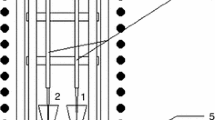Abstract
Heat capacity is a key subject in condensed matter physics due to its scientific and technological importance. Previous studies show that the change of heat dQ is dependent on both of the macroscopic physical variables in general solids: dT and dlnV. In this paper, we analyze the thermal parameters during the process of melting in a series of reference materials. The behavior of the heat of fusion and the volume change at melting in the reference materials can be explained by the new heat capacity model in solids. The change of volume at melting can be quantitatively gotten by the heat of fusion. The results are helpful to further understand the volume-dependent heat capacity in the model and the melting process in general materials.





Similar content being viewed by others
References
Einstein A. The Planck theory of radiation and the theory of specific heat. Ann Phys Berlin. 1907;327:180–90. https://doi.org/10.1002/andp.19063270110.
Debye P. The theory of specific warmth. Ann Phys Berlin. 1912;344:789–839. https://doi.org/10.1002/andp.19123441404.
Drebushchak VA. Thermal expansion of solids: review on theories. J Therm Analy Calorim. 2020;142(2):1097–113. https://doi.org/10.1007/s10973-020-09370-y.
Tang MB, Liu XC, Zhang MH, Pan XH. Scaling behavior of non-volume-dependent heat capacity in solids. Solid State Commun. 2022;341:114581. https://doi.org/10.1016/j.ssc.2021.114581.
Tang MB, Liu XC, Zhang MH, Pan XH, Wen HQ. Model of heat capacity in volume dimension. J Phys Chem A. 2020;124(29):6119–23. https://doi.org/10.1021/acs.jpca.0c05729.
Arblaster JW. Thermodynamic properties of beryllium. J Phase Equilibria Diffus. 2016;37(5):581–91. https://doi.org/10.1007/s11669-016-0488-5.
Nernst W. Analysis of the specific temperature of low temperatures. II. Sitzungsberichte K Preuss Akad Wiss. 1910:262–82.
Kaptay G. Approximated equations for molar volumes of pure solid fcc metals and their liquids from zero Kelvin to above their melting points at standard pressure. J Mater Sci. 2015;50(2):678–87. https://doi.org/10.1007/s10853-014-8627-z.
The periodic table of the elements. https://www.webelements.com
Tang MB, Pan XH, Zhang MH, Wen HQ. Scaling behavior between heat capacity and thermal expansion in solids. Chin Phys Lett. 2021;38(2):026501. https://doi.org/10.1088/0256-307X/38/2/026501.
Hixson RS, Winkler MA. Thermophysical properties of solid and liquid tungsten. Int J Thermophys. 1990;11(4):709–18. https://doi.org/10.1007/bf01184339.
McClure JL, Cezairliyan A. Measurement of the heat of fusion of tungsten by a microsecond-resolution transient technique. Int J Thermophys. 1993;14(3):449–55. https://doi.org/10.1007/bf00566044.
Tolias P, Team EUM. Analytical expressions for thermophysical properties of solid and liquid tungsten relevant for fusion applications. Nucl Mater Energy. 2017;13:42–57. https://doi.org/10.1016/j.nme.2017.08.002.
McClure JL, Cezairliyan A. Measurement of the heat of fusion of tantalum by a microsecond-resolution transient technique. Int J Thermophys. 1994;15(3):505–11. https://doi.org/10.1007/bf01563710.
Jager H, Neff W, Pottlacher G. Improved thermophysical measurements on solid and liquid tantalum. Int J Thermophys. 1992;13(1):83–93. https://doi.org/10.1007/bf00503358.
Garland CW. Generalized Pippard equations. J Chem Phys. 1964;41(4):1005–2000. https://doi.org/10.1063/1.1725997.
Hixson RS, Winkler MA. Thermophysical properties of molybdenum and rhenium. Int J Thermophys. 1992;13(3):477–87. https://doi.org/10.1007/bf00503884.
Paradis PF, Ishikawa T, Yoda S. Noncontact measurements of thermophysical properties of molybdenum at high temperatures. Int J Thermophys. 2002;23(2):555–69. https://doi.org/10.1023/a:1015169721771.
Desai PD. Thermodynamic properties of manganese and molybdenum. J Phys Chem Ref Data. 1987;16(1):91–108. https://doi.org/10.1063/1.555794.
Mehmood S, Klotz UE, Pottlacher G. Thermophysical properties of platinum–copper alloys. Metall Mater Trans A Phys Metall Mater Sci. 2012;43A(13):5029–37. https://doi.org/10.1007/s11661-012-1319-x.
Ubbelohde AR. Melting and crystal structure. Q Rev. 1950;4(4):356–81. https://doi.org/10.1039/qr9500400356.
Hixson RS, Winkler MA. Thermophysical properties of liquid platinum. Int J Thermophys. 1993;14(3):409–16. https://doi.org/10.1007/bf00566040.
Boivineau M, Arles L, Vermeulen JM, Thevenin T. Thermophysical properties of solid and liquid beryllium. Int J Thermophys. 1993;14(3):427–39. https://doi.org/10.1007/bf00566042.
Kubaschewski O. The change of entropy, volume and binding state of the elements on melting. Trans Faraday Soc. 1949;45(10):931–40. https://doi.org/10.1039/tf9494500931.
Wray PJ. Volume change accompanying solidification. Metall Trans. 1974;5(12):2602–3. https://doi.org/10.1007/bf02643883.
Levitt LS, Hsieh ET. Quasi-solid liquid lattice and volume change on melting of a solid - modified significant structure theory of liquids. 1. J Am Chem Soc. 1979;101(16):4664–8. https://doi.org/10.1021/ja00510a036.
Richards JW. Relations between the melting points and the latent heats of fusion of the metals. J Frankl Inst. 1897;143(5):379–83. https://doi.org/10.1016/S0016-0032(97)90124-1.
Badenhorst H, Bohmer T. Enthalpy of fusion prediction for the economic optimisation of salt based latent heat thermal energy stores. J Energy Storage. 2018;20:459–72. https://doi.org/10.1016/j.est.2018.10.020.
Chuvil’deev VN, Semenycheva AV. Model for the calculation of the volume change on melting of metals. Inorg Mater. 2017;53(7):770–3. https://doi.org/10.1134/s0020168517070020.
Kleinert H, Jiang Y. Defect melting models for cubic lattices and universal laws for melting temperatures. Phys Lett A. 2003;313(1–2):152–7. https://doi.org/10.1016/s0375-9601(03)00730-8.
Pippard AB. Thermodynamic relations applicable near a lambda-transition. Philos Mag. 1956;1(5):473–6. https://doi.org/10.1080/14786435608238127.
Lindemann FA. The calculation of molecular natural frequencies. Phys Z. 1910;11:609–12.
Eyring H. Viscosity, plasticity, and diffusion as examples of absolute reaction rates. J Chem Phys. 1936;4(4):283–91. https://doi.org/10.1063/1.1749836.
Acknowledgements
Liu acknowledges the financial support of the National Key Research and Development Program of China (2021YFA0716304) and Shanghai Science and Technology Innovation Action Plan Program (20511107404). Zhang acknowledges the financial support of Youth Innovation Promotion Association Chinese Academy of Sciences (2020256), Science and Technology Committee of Shanghai (20QA1410300, 22511100300), the Space Utilization System of China Manned Space Engineering (KJZ-YY-NCL07), Innovation Fund of Shanghai Institute of Ceramics Chinese Academy of Sciences (E19ZC3130G), and Science Research Fund of Shanghai Institute of Ceramics Chinese Academy of Sciences (E19ZC1990G). Pan acknowledges the financial support of Science and Technology Committee of Shanghai (19DZ1100703).
Author information
Authors and Affiliations
Contributions
Data collection was performed by MT. Data analysis was performed by MT, XL, MZ, and XP. The manuscript was written by MT. All authors discussed the results.
Corresponding author
Ethics declarations
Conflict of interest
The authors declare that they have no conflict of interest.
Additional information
Publisher's Note
Springer Nature remains neutral with regard to jurisdictional claims in published maps and institutional affiliations.
Rights and permissions
Springer Nature or its licensor (e.g. a society or other partner) holds exclusive rights to this article under a publishing agreement with the author(s) or other rightsholder(s); author self-archiving of the accepted manuscript version of this article is solely governed by the terms of such publishing agreement and applicable law.
About this article
Cite this article
Tang, M.B., Liu, X.C., Zhang, M.H. et al. Correlation between heat of fusion and change of volume at melting by volume-dependent heat capacity. J Therm Anal Calorim 148, 11167–11172 (2023). https://doi.org/10.1007/s10973-023-12424-6
Received:
Accepted:
Published:
Issue Date:
DOI: https://doi.org/10.1007/s10973-023-12424-6



